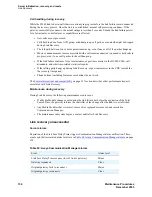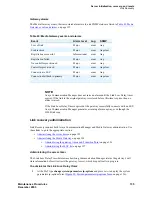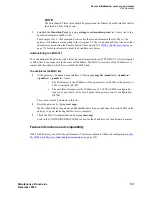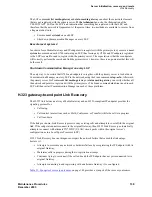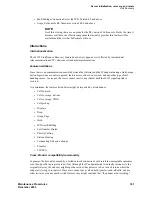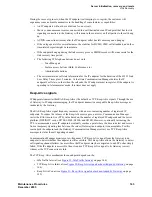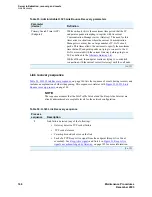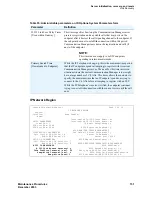
Server initialization, recovery, and resets
Link Recovery
138
Maintenance Procedures
December 2003
Network fragmentation
A likely outcome to an H.248 link recovery scenario is that a network of G700 Media Gateways and IP
endpoints, initially registered to the primary server, may now be registered to a number of different LSPs
in the network. This can be very disruptive in that network capability may be highly compromised.
Resources at various points in the network may be available in only limited quantities, or not at all.
Table 50: H.248 Link Recovery feature/adjunct interactions
Feature or adjunct
Description
Feature Access Codes (FAC)
Feature Access Codes, whether dialed or administered
buttons, do not work.
Non-IP trunks/stations, including
such circuit-switched TDM resources
as DCP, analog, or ISDN-PRI.
These resources are unavailable until the H.248 link is re-
established.
Terminals
Time-of-Day, busy lamp states, and call appearance status
on some phones might not instantaneously reflect the correct
information until the H.248 link is re-established.
Adjunct Switch Application Interface
(ASAI)
ASAI-based applications that utilize timing loops, time-
related methods, or events might not perform as intended. In
addition, applications that do not accommodate time-outs or
missing state transition(s) might behave unpredictably.
Voice mail adjuncts
(INTUITY, INTUITY Audix)
During Link Recovery, callers connected to AUDIX remain
connected even if they hang up. Such calls might be
automatically disconnected by AUDIX if the connection
remains intact without the calling party entering tone
commands to AUDIX or voicing a message.
Call Detail Recording (CDR)
Call records cannot reflect the correct disconnect time if the
calling party hangs up before the link recovers.
Call Management System (CMS)
Measurements collected during the recovery period might be
inaccurate in those reports that rely upon time-related data.
Property Management System (PMS)
Automatic Wake-up, Daily Wake-up, and Housekeeping
Status features might not operate as expected if the link fails
and the time to search for alternate resources exceeds the
PMS application’s time-out parameters.
For example, if a guest has a wake-up call schedule for 6:15
AM and the H.248 link goes down at 6:10 but recovers at
6:20, then the guest receives no wake up call at 6:15.
Conversant voice response systems
Conversant applications that utilize timing loops, time-
related methods, or events might not perform as intended. In
addition, applications that do not accommodate time-outs or
missing state transition(s) might behave unpredictably.
Summary of Contents for CMC1
Page 1: ...Maintenance Procedures 555 245 103 Issue 1 1 December 2003 ...
Page 14: ...Contents 14 Maintenance Procedures December 2003 ...
Page 416: ...Additional maintenance procedures IP Telephones 416 Maintenance Procedures December 2003 ...
Page 426: ...Index X 426 Maintenance Procedures December 2003 ...











